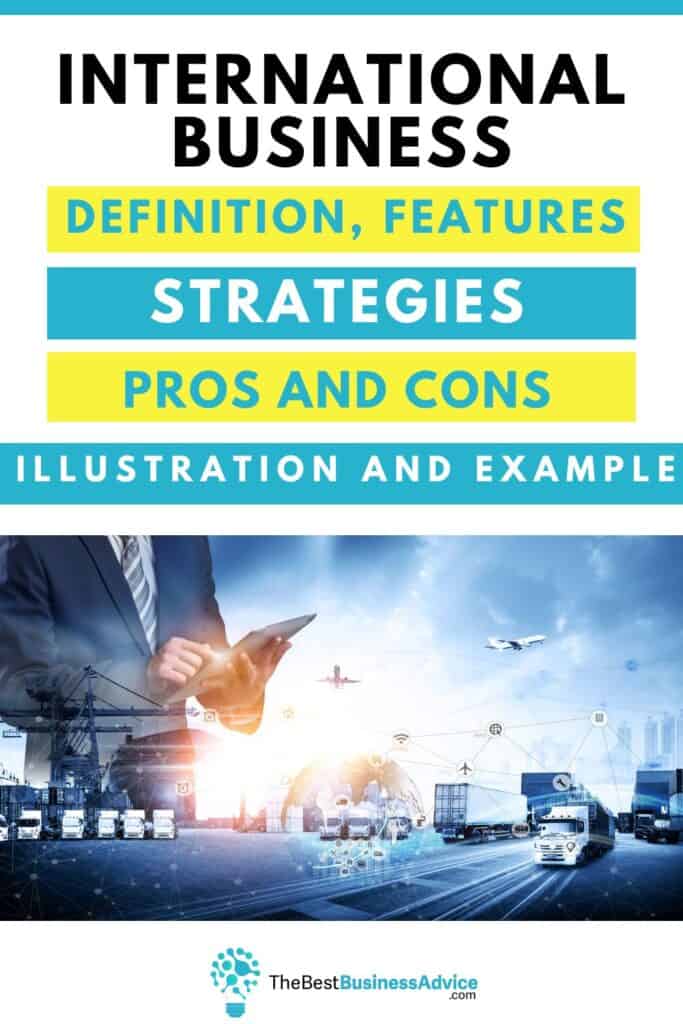International Business: Definition, Features, Strategies, Pros and Cons, Illustration and Example
In the modern era, economic activity has become increasingly international in the scope of its structures and processes. This globalized commerce presents unprecedented economic opportunities.
So, what are the defining aspects of this phenomenon called international business?
International business is economic activity that crosses the borders of multiple nation-states. This kind of commerce involves the movement of goods, services, people, knowledge, skills, capital, and resources across the globe via modern communication, information, and transportation technologies.
Companies are no longer bound to their domestic markets as tightly as before. Global commerce offers abundant possibilities for economic growth and profit-making. The following information should assist anyone wanting to gain a clearer understanding of international business and its cross-border systems and processes.

What Is International Business?
International business refers to economic or commercial activities conducted across national borders.
In international business, domestic markets are integrated through global production, distribution, and marketing networks. These networks facilitate the international flow of goods, services, labor, expertise, natural resources, and capital.
International business presents several valuable opportunities to access new markets, improve logistical efficiencies, and reduce operational costs. Firms that capitalize on these opportunities can achieve revenue and profit growth that would be impossible within the confines of a single country.
The process of globalization has created the conditions for the increase in internationalized forms of business. Dramatic advances in communication and data processing technologies, together with faster, more efficient transportation have made international business easier and cheaper than ever to undertake.
Globalization has also seen the loosening of trade barriers between countries, creating new opportunities for companies seeking to do business in foreign countries.
An archetypal example of international business is Nike. Nike is a US company that manufactures its shoes, apparel, and accessories in Asian countries, and distributes these products to dozens of countries.
Features Of International Business
Several features distinguish international forms of business from local or domestic commerce.
Cross-Border Economic Activity
Perhaps the most characteristic feature of international business is that commercial activities traverse national boundaries.
As noted above, international business involves the cross-border movement of raw materials, manufactured goods, services, people, knowledge, skills, and financial resources.
The possibilities for doing business across national borders have dramatically expanded due to the liberalization of international trade.
In the era of globalization, cooperation between countries has grown. Under the rules of the World Trade Organization (WTO) and bilateral and regional trade agreements, national governments have been legally obliged to reduce or remove legal barriers that previously hindered cross-border commerce.
Reliance On Technology
Another definitive feature of international business is the reliance on advanced modern technology.
International business depends on digital communication technologies to enable the instantaneous exchange of information between distant locations.
Commercial entities use the internet, computers, and smartphones for seamless communication. These digital communication technologies enable companies to coordinate their operations and strategies and to engage with other businesses in different parts of the globe.
The other critical role that digital technology plays in international business revolves around data processing. Companies use advanced information technology systems to gather, organize, store, and share business-related data.
In addition, international business relies on modern transportation to move raw materials and manufactured products through global logistical networks. Shipping, air freight, and railways function like the arteries of international business.
Large-Scale Firms
The dominance of large-scale firms is one of the core attributes of international business.
Conducting commercial activities at a global scale is a complex endeavor that requires significant organizational capacity and financial resources.
Large-scale companies like multinational companies have access to the capital, assets, knowledge, and skills necessary for engaging in international business. This is why corporations and other big firms predominate in the arena of international business.
Most small to medium-sized companies lack the resources and capacity to establish and manage commercial ventures that traverse national boundaries.

Types Of International Business
There are several types of international business. Each type has specific commercial processes, aims, and objectives.
Export-Import
Exporting and importing involve sales and transportation of products between two independent enterprises in different countries.
Exporting offers companies a direct means of accessing and generating revenue in foreign markets. In addition, companies earn more for their products when they export them, compared with selling the same goods domestically.
Importing allows firms to access raw materials and manufactured goods that are not locally available. While importation involves added costs, i gives companies a competitive advantage.
Licensing
Licensing is a type of international business that allows companies in one country to access and use the intellectual property of individuals and firms in other countries.
In licensing agreements, the owner of a patent, trademark, or brand leases their intellectual property to another party (the licensee). The licensee receives the legal right to use these intangible commodities according to specific limitations set out in the agreement.
Licensing allows firms to benefit from technological advances and brand recognition achieved by individuals and businesses beyond national boundaries.
Franchising
Another type of international business closely related to licensing is called franchising.
In this form of commerce, a firm (the franchisor) leases their business model, trademarked brand, and operational procedures to franchisees. The franchisees pay fees to gain the right to use that intellectual property to open independent business units that they partly own.
In the case of international business, franchising is a growth strategy that enables companies to access and generate revenue in foreign markets. Franchisees obtain the benefits of a ready-made and proven business model and the chance to operate under the banner of an established brand.
Turnkey Projects
Turnkey projects are a more specialized type of international business. In this kind of cross-border commerce, a contractor designs and implements a project (such as a housing development) that is sold to another company.
Contractors are entirely responsible for the conception and completion of turnkey projects. The buyers have no involvement in the process and take ownership of the project as a finished product.
Wholly-Owned Subsidiaries
Wholly-owned subsidiaries are a widely-used international business type.
As the name indicates, a wholly-owned subsidiary is an enterprise that is a sub-unit of a larger parent company. The parent company owns 95% to 100% of the voting securities in the subsidiary company.
Parent firms play a dominant role in the operations, management, and financing of wholly-owned subsidiaries.
Corporations and other firms establish or acquire wholly-owned subsidiaries in foreign countries to gain a foothold in those markets. A challenge of this type of international business is that the parent company needs the capacity to successfully control and direct the subsidiary in a new and unfamiliar country.
Joint Ventures
Firms commonly undertake cross-border economic activity via the joint venture model.
Joint ventures are commercial entities created by two or more individuals or firms for a specific business purpose. Unlike in wholly-owned subsidiaries, the parties in a joint venture share responsibility, influence, and control over the enterprise.
Each of the parties in a joint venture adds capital, assets, labor, and expertise to the enterprise. In most cases, joint ventures are formed so the parties can combine their unique strengths and capabilities to achieve synergistic outcomes.
Joint ventures are used widely in the context of international business. Firms usually seek to create this kind of enterprise as means to access new markets. By forming a joint venture with a domestic company, foreign firms benefit from the latter’s knowledge of local market conditions and regulatory frameworks.
Strategies For International Business
There are several strategies that firms choose to pursue in the field of international business. Companies use these strategies as frameworks or models that guide their operational and management processes.
The two central variables that international business strategies consider are:
- costs – the economic efficiency of the firm,
- responsiveness – the ability of the firm to meet local needs and preferences.
The four principal strategies for conducting business across national borders are distinct in their approaches. Each strategy prioritizes the variables of costs and responsiveness differently and has unique advantages and disadvantages.
Multi-Domestic
The multi-domestic strategy prioritizes local responsiveness over costs.
Foreign firms pursuing this strategy customize their products and services to suit the local market. The advantage of this strategic focus is that the firm makes its offerings more appealing to consumers in the country.
A challenge with the multi-domestic strategy is that responsiveness comes at the expense of efficiency. This strategy does not allow for the standardization of operations across multiple countries, so firms lose the ability to minimize costs through economies of scale.
International
The international strategy is relatively straightforward. Companies distribute and retail their goods and services in multiple countries without prioritizing responsiveness or cost minimization.
With the international strategy, firms do not alter their products to align with local markets and are unconcerned with competitive pricing.
The international strategy is optimal for companies whose brands and high-quality products are already well-recognized and desired in foreign markets. These firms do not need to adapt their products and can charge premium prices because the local demand for their wares is so strong.
Global
With the global strategy for international business, firms prioritize economic efficiency over responsiveness.
The strategy focuses on standardizing organizational processes and product characteristics to achieve economies of scale across international operations. By minimizing costs, firms gain a competitive advantage because they can offer consumers low prices than other companies.
The disadvantage of the global strategy is that the emphasis on standardization precludes companies from tailoring their offerings to domestic market preferences.
Transnational
Companies choosing the transnational strategy in international business seek to balance cost and local responsiveness. In this sense, this strategy enables firms to combine the strengths of multi-domestic and global strategic approaches.
Firms using the transnational strategic model benefit from cost efficiencies by creating uniformity across the international throughout their foreign business units. In each country where the firms operate, their production, distribution, management, and marketing systems are integrated and virtually identical.
The transnational strategy also prioritizes responsiveness to domestic market demands and desires. Companies generally sell a standard range of products (for efficiency) but enhance their offerings by adding items customized to local market preferences.
International Business Elements
There is a complex set of economic, social, political, and environmental elements in international business. These elements make trans-border economic activities possible.
Firms
Firms are the primary economic actors or entities that participate in the arena of international business.
Multinational corporations are the most common firms operating in international business. These companies span two or more countries, with extensive financial resources and organizational capabilities.
Goods And Services
The goods and services that firms produce, distribute, and sell are also essential elements of international business.
These economic outputs take diverse forms, ranging from raw materials to manufactured products.
Business Operations
The commercial operations that firms undertake are elemental to international business.
The operational systems and processes that drive international business include:
- natural resource extraction (such as mining),
- production and manufacturing,
- supply chain logistics,
- human resource management,
- marketing and advertising.
Markets
Markets are fundamental elements in cross-border commerce. National, regional, and global economies and populations produce and consume the goods and services created through international business.
Market conditions like consumer demand, availability of resources, and competition between firms are crucial in dictating international business opportunities and risks.
Legal And Policy Systems
International business also has regulatory elements. Commercial and economic laws and policies set the limits within which firms are obliged to act.
When doing business across borders, companies are bound by the legal and policy frameworks that prevail in each country where they operate. Companies must also comply with international laws and policies governing cross-border business activities.
Social And Political Conditions
Social and political conditions are critical elements in international business. International business is most successful when undertaken in conditions of social and political stability.
Conversely, cross-border commerce is challenging (and sometimes impossible) in countries with high levels of violence or armed conflict.
Geography
A foundational element in international business is natural geography. Geography determines the economic activities that are possible or commercially viable in a particular area.
When operating across multiple countries and continents, companies contend with local and regional geographical factors such as:
- climate and weather,
- topography,
- availability of water and other vital resources,
- proximity to rivers and oceans,
- natural disasters.
Pros And Cons
Globalized economic activity poses significant opportunities for societal gain, but there are also potential risks.
The scale and scope of international business create the possibilities for positively influencing large populations in a short period. This capacity to create dramatic, large-scale impacts on people and the environment also poses risks.
These are some of the pros and cons of international business.
Stimulating Economic Growth
Conducting business International business offers myriad opportunities to stimulate economic growth.
Cross-border commerce enables companies to increase their revenue and profits while also contributing to improved economic prospects in societies where firms are active.
International business supports economic growth by creating or enhancing access to:
- resources,
- knowledge,
- labor,
- employment,
- consumer markets.
Another way that international business boosts economic growth is that domestic firms can capitalize on their competitive advantages. In a global marketplace, companies with specialized or unique goods, services, or production methods can differentiate themselves from their competitors and gain market share.
Enhancing Global Cooperation
Commercial transactions between firms in multiple countries and the linking of disparate markets generally enhance global cooperation.
International trade and economic integration produce incentives for continued cooperation between companies in different countries. These mutually beneficial business relationships also encourage the governments in those countries to work together rather than compete.
Harmful Competition
One of the potential drawbacks of international business is that it exposes domestic firms to increased competition.
In some cases, local companies in developing countries lack the financial resources and organizational capacity to compete successfully with foreign firms from wealthier nations.
Companies in developed countries can also suffer from the increased competition associated with international business. This often occurs when firms from poorer regions with low labor costs out-compete firms in developed countries by offering the same products at dramatically lower prices.
Negative Social And Environmental Impacts
International business can also have negative social and environmental impacts. Foreign firms operating in less developed countries sometimes exploit and endanger their local workforce due to the laxity of domestic labor laws.
Multinational companies also use complex legal maneuvers to avoid paying taxes in the countries where they operate and generate profits. The loss of tax revenue undermines the capacity of national governments to meet their citizens’ needs spending and In many instances, international business also contributes to environmental harm.
The global expansion of industrial production and distribution networks creates increased air and water pollution that compromises the health of local ecosystems.
Wrap Up
International business is a mode of economic activity characterized by the flow of goods, services, capital, and labor across national borders. Conducting business internationally enables firms to expand their operations into foreign markets where they can pursue new profit-making opportunities.
PIN THIS FOR LATER…
DID YOU FIND THIS INFORMATION HELPFUL? Share the love on social.
Follow us on Pinterest & Instagram!
ANY OTHER BUSINESS ADVICE WE CAN WRITE ABOUT?
Let us know, email us at: Advice@TheBestBusinessAdvice.com

![]()








